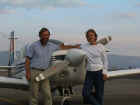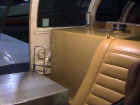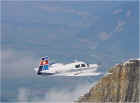Mooney M20E (s/n 807, short cabin, 200 hp Lycoming fuel injected IO-360-A1A engine) was born in August 1965 in Kerrville, Texas at the Mooney aircraft factory. It was soon flown across the Atlantic to Switzerland where it acquired its present Swiss registration HB-DVN.
Need to be IFR rated and equipped (1980)
For the first 13 years of its life, it was a bit of a hangar queen as it only had 700 hours total when I bought a 50% share of it in July 1978. It had spent all its life in a hangar and had no damage history. Two years later, it became clear to me that I needed to get it IFR equipped and I needed an instrument rating as far too often I had to leave the plane behind somewhere in Europe and take the train home. So in 1980 I bought the other 50% share of the plane from my co-owner, bought a lot of new radios to comply with Swiss IFR regulations, and went for 4 weeks to Vero Beach, Florida to get my instrument and commercial ratings. Each of these two tasks required a significant effort in terms of time and money.
Engine overhaul and Swiss Aircraft Mechanics license (1981)
In 1981 the original IO-360-A1A engine was up to its 1200 hour TBO (main bearings and camshaft AD's) and I got it overhauled locally. I went to courses during the whole winter to get my Swiss aircraft mechanics license so I could replace the engine myself and sign off the required regular annual inspections.
Aerodynamical improvements (speed kits) and improvements (1982-1988)
Although the Mooney M20E was faster than most 200 hp competitions (Cessna Cardinal, Piper Arrow, Aero Commander) it was still almost 20 knots slower than the most recent 200 hp M20J which appeared under the trade name of 201 in 1977 after numerous aerodynamic clean-ups by Roy Lopresti. Paul Loewen of Lake Aero Styling in Lakeport, California, soon got STC approvals for numerous retrofit kits which dramatically improved the cruise performance and which copied many of the drag reducing measures which Roy Lopresti had introduced on the new M20J's.
I bought most of these kits and STC's, and with the help of a Swiss aircraft mechanic friend, Jacques Gaillard of Aeronord, Yverdon, I installed these kits and obtained Swiss approval for these major alterations. In 1982 flap gap seals, aileron gap seals, tail root fairing, elevator and rudder hinge fairings, inner gear doors and wing root fairing were added. A few years later I added the M20J style windshield and replaced the old M20E cowling with a new M20J fiberglass cowling. Besides better looks, the new cowling and spinner avoids the excessive cooling of the cylinders common in the M20E, reduce the cooling drag in cruise, provides much easier access to engine accessories for maintenance, and relocates the oil cooler to a location where it is protected from damage by heavy rain.
After all these modifications I had a Mooney which empty was almost 200 lbs lighter than the M20J and significantly faster. The simple manual Johnson bar for gear retraction and hydraulic flap system saves a lot of weight compared with the electrical gear and flap motors. In a formation flight with a similar loaded 1988 M20J belonging to a Mooney friend and with identical power settings and fuel flow, it was about 5 knots faster than the M20J. Alternatively, we tried my M20E with best economy mixture at 8 GPH and the M20J at best power mixture at 11 GPH which resulted in identical cruise speeds. Lots of money and time spent on these speed kits, but worth it especially for long range flights where fuel savings are worth a lot. Compared with others means to go faster (turbocharging and more power) these speed kits are maintenance free, saves fuel and increase the range.
Extended range, Monroy tanks installed, HF, repaint and nickname 'Honey-Mooney' (1988)
In December 1981and January 1982 I flew the bird to Nairobi, Kenya and back along the Nile via Cairo, Aswan, Khartoum and Juba. Fuel in Sudan was very difficult to obtain, and it was only thanks to friends located in Khartoum and Juba that it was at all possible. And reserves with standard 52 USG wing tanks were certainly marginal for flying around in the middle of black Africa with 700 NM or so to the nearest alternate airport.
After this experience I was quick to buy in 1988 an STC'd kit from Jose Monroy in Florida, which adds two extra integral tanks of 17 USG each in the wings. They are installed by sealing off existing wing compartments. Due to air pockets being effectively filled with fuel in the main tanks, this increased the fuel capacity to 88 USG or about 10:30 hrs of economy cruise at 8 USG/hour and 150 knots. After this fuel tank installation I flew the bird to Kenya again with Angela for our 6 week honeymoon and flying safari in Kenya and Tanzania in East Africa. We had to avoid Sudan due to wars in southern Sudan, and could comfortably make it from Iraklion, Crete to Nairobi Wilson, Kenya via the Red Sea and with only two refueling stops: Luxor in Egypt and Djibouti. To ensure better safety and adequate communication while flying through remote areas of Africa we also installed a 14V Australian 28-channel Codan HF2003 HF transceiver.
As the bird had been repainted just a month before the honeymoon trip, we decided to baptize it 'Honey Mooney'
In 1991 Angela and I flew the bird to California via Iceland and Greenland as I had been invited to work at Stanford Linear Accelerator Center in California for a year. The Garmin 100 GPS receiver had just become available making oceanic navigation a piece of cake in spite of partial coverage due to limited number of satellites at that time. The 88 USG fuel capacity was comfortable for this northern route, but the weather is often tricky along this route: icing over the Greenland ice cap and fog at coastal Greenland airports are common. For the trip home via the Azores (possible thanks to a Codan HF2003 HF transceiver installed in 1988) we needed to add a temporary tank of 12 USG on the rear seat to have adequate reserves for the 1400 NM from St. Johns to Santa Maria in the Azores.
Engine Overhaul again, new certified 35 USG tank on rear seat (1996)
In 1996 engine TBO was up again and the compression of two cylinders were rapidly decreasing. This time I opted for a Lycoming factory overhaul exchange with new cylinders as the US$ exchange rate was very good.
At the same time a good friend of mine, Armand Pereira, who spent many years in Brazil persuaded me to make a commemoration flight to Rio de Janeiro to celebrate 75 years since Gago Coutinho and Sacadoura Cabral's heroic crossing of the South Atlantic in 1922.
However I needed a lot more extra fuel to have adequate reserves for the 1650 NM hop from Sal, Cape Verde Islands to Recife, Brazil. There is an airport at Fernando de Noronha island, but no fuel nor customs there. I designed a welded aluminum 35 USG tank to be installed at the location of the rear seat and with permanent aluminum fuel lines and fuel selector valve installed under the floorboard. It was approved by the Swiss FOCA in Bern and I obtained a permanent Aircraft Flight Manual Supplement including a 15% overgross take-off authorization for this installation. Due to the permanent fuel lines installed and the Lake Aero Styling fold down rear seat modification installed in 1994, the tank can be installed and removed in less than an hour. The fuel capacity in this configuration is 123 USG or 15 hours of economy cruise at 8 GPH and 148 knots. About a 4 hour reserve for the intended flights Sal - Recife and Natal - Dakar. Nevertheless I had the unpleasant experience to have to turn around after 4:30 hours on the return trip from Natal to Dakar due to unexpected and unforecast persistent headwinds of more than 35 knots - a rare thing in the tropics, but it did happen.
Getting ready for the Round the World flight, further range extension, 150 USG (2001)
For the round the world flight in 2001/2002, the aircraft is being operated with the wing tanks only and 3 persons on board (Angela, Ray and myself) from Geneva to Auckland, New Zealand. For the rest of the trip eastbound over the Pacific and South Atlantic, the 35 USG tank will be installed in Auckland and we will be 2 persons on board: Angela and myself.
However, for the 2012 NM leg from Hilo, Hawaii to Monterey, California 15 hours of fuel is not enough. So in September 2001 I obtained approval for yet another tank of 27 USG to be installed in place of the co-pilots seat. This increases the fuel capacity to 150 USG or 18:30 hours of economy cruise. In this configuration the airplane is a single seater, and Angela and the co-pilots seat will go by airline for this leg.
Unison LASAR electronic ignition (2000)
Unison Industries put an STC approved electronic ignition system called LASAR on the market a few years back. They claim an improved fuel efficiency of up to 8 to 10% due to adaptive spark advance timing, especially at the low power settings commonly used for long range cruise. I installed such a system in May 2000, but so far I have unfortunately not been able to measure any improvements in speed or fuel efficiency. I also installed a light weight STC'd starter motor which saves a lot of weight and cranks the engine a lot faster. That weight saving is real!
After almost 24 years of ownership, two engine replacements, some 30 or so 100 hour inspections, and more than 3000 flying hours, I have developed a rather affectionate relation with this wonderful airplane so well designed and built. It is a bit cramped spacewise and it is rather difficult to get in and out, but once you are in it is lovely!
Honey Mooney over Dents du Midi in the Swiss alps September 2001.
Photo: Gerard Moss

Honey Mooney over Lausanne, Switzerland. Technically it is an M20E, but it looks like an M20J with short cabin. Photo: Joe Rimensberger

Geneva July 2001. We had made the firm decision to fly around the world in 7 months

October 2001. The 35 USG (Brazil model) and 27 USG (Hawaii model) installed in the cabin for approval and test.
